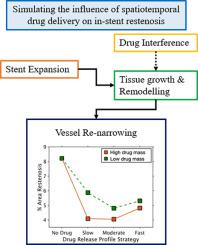Journal of Controlled Release ( IF 10.5 ) Pub Date : 2022-08-12 , DOI: 10.1016/j.jconrel.2022.07.037 Alistair McQueen , Javier Escuer , André Fensterseifer Schmidt , Ankush Aggarwal , Simon Kennedy , Christopher McCormick , Keith Oldroyd , Sean McGinty

|
Since the introduction of percutaneous coronary intervention (PCI) for the treatment of obstructive coronary artery disease (CAD), patient outcomes have progressively improved. Drug eluting stents (DES) that employ anti-proliferative drugs to limit excess tissue growth following stent deployment have proved revolutionary. However, restenosis and a need for repeat revascularisation still occurs after DES use. Over the last few years, computational models have emerged that detail restenosis following the deployment of a bare metal stent (BMS), focusing primarily on contributions from mechanics and fluid dynamics. However, none of the existing models adequately account for spatiotemporal delivery of drug and the influence of this on the cellular processes that drive restenosis. In an attempt to fill this void, a novel continuum restenosis model coupled with spatiotemporal drug delivery is presented. Our results indicate that the severity and time-course of restenosis is critically dependent on the drug delivery strategy. Specifically, we uncover an intricate interplay between initial drug loading, drug release rate and restenosis, indicating that it is not sufficient to simply ramp-up the drug dose or prolong the time course of drug release to improve stent efficacy. Our model also shows that the level of stent over-expansion and stent design features, such as inter-strut spacing and strut thickness, influence restenosis development, in agreement with trends observed in experimental and clinical studies. Moreover, other critical aspects of the model which dictate restenosis, including the drug binding site density are investigated, where comparisons are made between approaches which assume this to be either constant or proportional to the number of smooth muscle cells (SMCs). Taken together, our results highlight the necessity of incorporating these aspects of drug delivery in the pursuit of optimal DES design.
中文翻译:

支架药物剂量和释放速率之间复杂的相互作用决定了动脉再狭窄
自从引入经皮冠状动脉介入治疗 (PCI) 治疗阻塞性冠状动脉疾病 (CAD) 以来,患者的预后已逐渐改善。使用抗增殖药物来限制支架部署后过度组织生长的药物洗脱支架 (DES) 已被证明是革命性的。然而,使用 DES 后仍会发生再狭窄和需要重复血运重建。在过去几年中,出现了计算模型,详细说明了裸金属支架 (BMS) 部署后的再狭窄,主要关注力学和流体动力学的贡献。然而,现有的模型都没有充分说明药物的时空传递及其对驱动再狭窄的细胞过程的影响。为了填补这个空白,提出了一种结合时空给药的新型连续再狭窄模型。我们的研究结果表明,再狭窄的严重程度和时间进程严重依赖于药物输送策略。具体来说,我们发现了初始载药量、药物释放率和再狭窄之间复杂的相互作用,这表明仅仅增加药物剂量或延长药物释放时间以提高支架疗效是不够的。我们的模型还表明,支架过度扩张的水平和支架设计特征,如支柱间距和支柱厚度,会影响再狭窄的发展,这与实验和临床研究中观察到的趋势一致。此外,研究了决定再狭窄的模型的其他关键方面,包括药物结合位点密度,在假设这与平滑肌细胞 (SMC) 的数量恒定或成比例的方法之间进行比较。总之,我们的结果强调了将药物递送的这些方面纳入追求最佳 DES 设计的必要性。











































 京公网安备 11010802027423号
京公网安备 11010802027423号